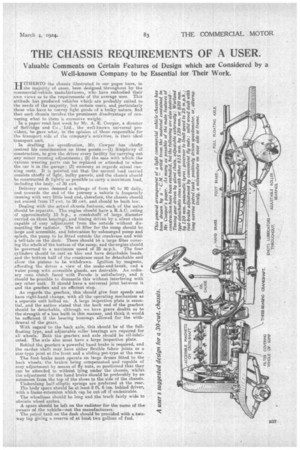THE CHASSIS REQUIREMENTS OF A USER.
Page 21

If you've noticed an error in this article please click here to report it so we can fix it.
Valuable Comments on Certain Features of Design which are Considered by a Well-known Company to be Essential for Their Work.
HITHERT'O the chassis illustrated in onr pages have, in _Lithe majority of cases, been designed_throughout by the commereial-vehkle manufacturers, who have embodied their
own views as to the requirements of the average user. This attitude has produced vehicles which are probably suited to the needs of the majority, but certain users, and particularly those who have to convey light goods of a bulky nature, find that such chassis involve the prominent disadvantage of conveying what to them is excessive weight. In a paper read last week by Mr. A. E. Cowper, a director of Selfridge and Co., Ltd., the well-known universal pro viders, he gave what, in the opinion of those responsible for the transport side of the company's activities, is their ideal transport unit.
In drafting his specification, Mr. Cowper has chiefly centred his consideration on three points :—(1) Simplicity of construction, to give the driver every facility for carrying out any minor running adjustments; (2) the ease with which the various wearing parts can be replaced or attended to when the car is in the garage; (3) economy as regards actual running costs. It is pointed out that the normal load carried consists chiefly of light, bulky parcels, and the chassis should be constructed is lightly as possible ta carry a maximum load, including the body, of 30 ewt, Delivery areas demand a mileage of from 60 to 90 daily, and towards the end of the journey a vehicle is frequently running with very little load and, therefore, the chassis should not exceed from 17 cwt. to 20 cwt. and should be built low.
Dealing with the actual chassis features, each of the units should be separate. The engine should have a R.A.C. rating of approximately 15 h,p., a crankshaft of large diameter carried on three bearings, and timing driven by a silent chain capable of easy adjustment from the outside without dis mantling the radiator. The oil filler for the sump should be large and accessible, and lubrication by submerged pump and splash, the pump to be fitted outside the crankcase and with a tell-tale on the dash. There should We a large filter covering the whole of the bottom of the sump, and the engine should be governed to a maximum speed of 25 m.p.h. The four cylinders should be cast en bloc and have detachable heads.
and the. bottom half of the crankcase must be detachable and allow the pistons to be withdrawn. Ignition by magneto, affording the driver a view of the make-and-break, and a water pump with accessible glands, are desirable. An ordinary cone clutch faced with Ferodo is satisfactory, and it should be possible to dismantle this without interfering with any other unit. It should have a universal joint between it and the gearbox and an efficient stop.
As regards the gearbox, this should give four speeds and have right-hand change, with all the operating mechanism as a separate unit bolted on. A large inspection plate is essen tial, and the author stated that the back end of the gearbox should he detachable, although we have grave doubts as to the strength of a box built in this manner, and think it would be sufficient if the bearing housings allowed for the withdrawal of the gears.
With regard to the back axle, this should be of the full. floatingtype, and adjustable roller bearings are required for all wheels. Both the gearbox and axle should be oil-lubricated. The axle also must have a large inspection plate.
Behind the gearbox a powerful hand brake is required, and the cardan shaft may have either flexible fabric joints or a star-typo joint at the front. and a sliding pot-type at the rear.
The foot brake must operate on large drums fitted to the back wheels, the brakes being compensated and capable of easy adjustment by means of fly nuts, so positioned that they can be attended to without lying under the chassis, whilst. the adjustment for the hand brake should be preferably by an extension from the top of the shoes to the side of the chassis. Underslung half-elliptic springs are preferred at the rear. The body space should be at least 8 ft. 6 ins, behind driver, with a frame extension which can be cut off if undesirable.
The wheelbase should be long and the track fairly wide to obviate wheel arches.
A space should be left on the -radiator for the name of the owners of the vehicle—not the manufacturers.
The petrol tank on the dash should be provided with a twovey tap giving a reserve of at least two gallons of fuel.






























